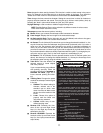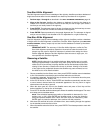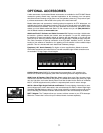
30
8.
Use the Arrow keys to center the object in the eyepiece to view the object. Satellite orbits
change and new satellites (including the Space Shuttle) are launched. Visit the Meade
website (
www.meade.com) approximately once a month to get updated information and
instructions on how to download this data to AutoStar. If orbital parameters are more than
one month old, the satellite pass ma
y not happen at the time predicted by AutoStar. To
download new satellite data into AutoStar memory requires the optional Astrofinder
Softw
are and Cable Connector Kit. See
OPTIONAL ACCESSORIES, page 32.
Digital Photography with the ETX
Although digital camer
as still cannot match the quality of images provided by
traditional 35mm cameras, they provide some significant advantages to the casual astropho-
tographer: You do not have to develop the images (instant images), lower costs, computer and
internet readiness. And because unwanted photos are easily discarded, they provide the
freedom to experiment.
Digital cameras present some problems for the astrophotographer: Many models have lenses
that cannot be removed, present difficulties in attaching to a telescope, often lack manual focus-
ing and allow limited exposure times. Long exposures with digital cameras introduce undesir-
able noise and artifacts into a digital image. This limits the range of astro images to the Moon,
planets and bright stars.
SLR digital cameras usually work the best for astrophotography, although they are still a bit
pricey.
Some tips for better photos:
• If you cannot remove the lens to your camera, look for a commercially available digital
t-adapter. New solutions for attaching a digital camera to a telescope are becoming
available as time goes by.
• If the camera is not directly coupled to the eyepiece, keep it as close to the
eyepiece as possible and center the image to be photographed to minimize vignetting
(darkening of the edges of the photo).
• Try to block ambient light (from street lights, house, etc.) from the eyepiece and the cam-
era with a piece of cardboard, a screen, etc.
• Keep extra (charged) batteries on hand for your camera as digital cameras often drain bat-
teries in a short period of time. Rechargeable Lithium batteries provide power for a longer
period than non-rechargeable batteries. If practical, use an AC adapter.
• If using manual focus, set to infinity. Otherwise, using the camera's autofocus is OK.
• Experiment with your camera's exposure, brightness and /or contrast settings. Keep notes
for future reference.
• Many digital cameras have a manual ISO setting. Short exposures times work the best.
• Use your camera's highest image quality and lowest compression settings. Although this
fills up your camera's memory more quickly, it produces the best quality photos.
• Use the camera's timer or remote shutter release (if available for your camera) to minimize
vibration.Wireless shutter releases may be available for some model digital cameras.If you
do not have a shutter release, use the camera’s timer (sometimes called “self-timer”), which
is available with most digital cameras. The timer also minimizes vibration.
Photography with Meade’s AutoStar Suite™
The AutoStar Suite with Meade LPI™ (Lunar Planetary Imager) or Meade Deep Sky Imager™
turns your Meade ETX telescope, AutoStar and PC into even more powerful and easy-to-use
astronomical 5. Press GO TO. AutoStar slews the telescope to where the satellite should
appear. The motor drive stops and a countdown starts.
NOTE: If the scheduled appearance position of the satellite is obstructed (i.e., by a
b
uilding, tree
, or hill), press ENTER and A
utoStar star
ts to mo
v
e the telescope
along the e
xpected satellite track. When the track clears the obstruction, press
ENTER again to pause the telescope, then continue with this procedure.


















